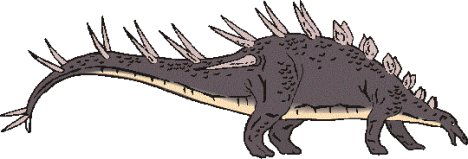
 |
Kentrosaurus
Click here for more Kentrosaurus Pictures
It was about 16 feet (4.9 meters) long, and weighed around 2 tons. Kentrosaurus may have been slow-moving, but it was well protected from predators by its armor. Its back was covered with a double row of triangular bony plates on each side of the backbone. At the rear, the plates were then replaced with pairs of sharp spikes, about 2 feet (60 centimeters) long, that went from the lower back down to the tip of the tail. There was also a pair on extra long spikes on the hips. Kentrosaurus was one of the Fossils brought back from the 1909-1912 German expedition to East Africa. Edwin Henning, who was one of the paleontologists on this expedition, published the first full description of Kentosaurus in 1915. A nearly complete skeleton of Kentrosaurus once stood in the Humboldt Museum in the University of Berlin, however, unfortunately, this was lost as a result of bombing during World War II. Although it usually believed that Kentrosaurus died out millions of years ago, there are some cryptozoologists (people who search for rumored or mythical animals whose existence is uncertain) have suggested that "Mbielu-Mbielu-Mbielu", an animal claimed to be known to villagers in the Northern part of the Republic of Congo, might just be a living Kentrosaurus. However, as yet, there does not seem to be any definitive proof of this. For more information see Living Dinosaurs? Kentrosaurus Timeline:Kentrosaurus was a herbivore (plant-eater) that lived from 156 to 150 million years ago
Related Information & ResourcesRelated Web Sites
Kentrosaurus Facts
Linking to This PageWe do hope that you find this site useful. We welcome people linking to this website or citing us. |
|
|